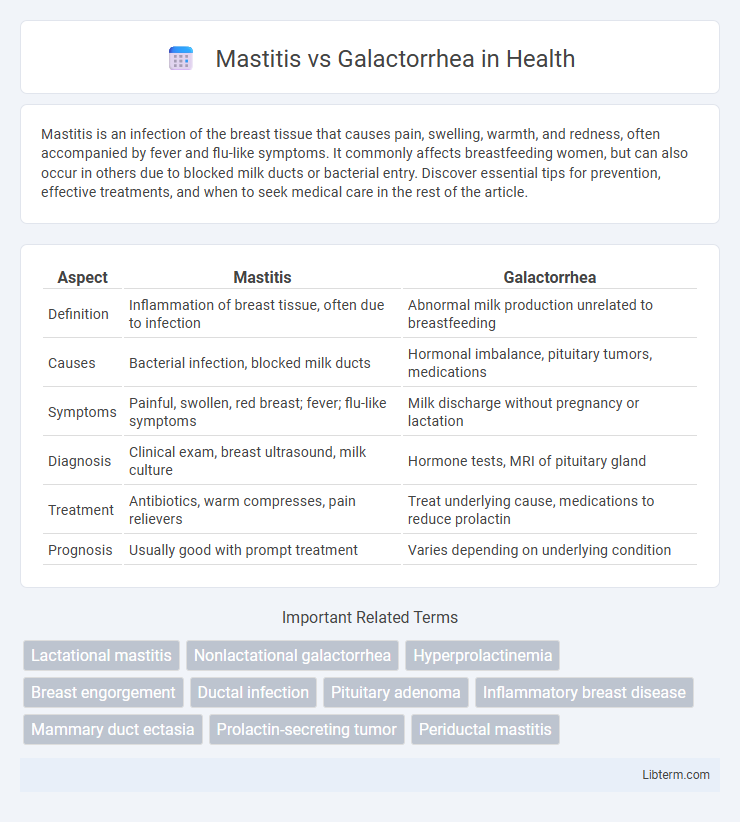Mastitis is an infection of the breast tissue that causes pain, swelling, warmth, and redness, often accompanied by fever and flu-like symptoms. It commonly affects breastfeeding women, but can also occur in others due to blocked milk ducts or bacterial entry. Discover essential tips for prevention, effective treatments, and when to seek medical care in the rest of the article.
Table of Comparison
| Aspect | Mastitis | Galactorrhea |
|---|---|---|
| Definition | Inflammation of breast tissue, often due to infection | Abnormal milk production unrelated to breastfeeding |
| Causes | Bacterial infection, blocked milk ducts | Hormonal imbalance, pituitary tumors, medications |
| Symptoms | Painful, swollen, red breast; fever; flu-like symptoms | Milk discharge without pregnancy or lactation |
| Diagnosis | Clinical exam, breast ultrasound, milk culture | Hormone tests, MRI of pituitary gland |
| Treatment | Antibiotics, warm compresses, pain relievers | Treat underlying cause, medications to reduce prolactin |
| Prognosis | Usually good with prompt treatment | Varies depending on underlying condition |
Understanding Mastitis and Galactorrhea
Mastitis is an inflammation of breast tissue often caused by bacterial infection, leading to pain, swelling, redness, and fever, mainly affecting breastfeeding women. Galactorrhea is characterized by inappropriate or excessive milk production unrelated to childbirth or nursing, commonly resulting from hormonal imbalances, medications, or pituitary gland disorders. Differentiating mastitis from galactorrhea involves recognizing infection symptoms versus hormonal causes, which guides treatment strategies such as antibiotics for mastitis and hormonal therapy or addressing underlying conditions for galactorrhea.
Key Differences Between Mastitis and Galactorrhea
Mastitis primarily involves inflammation of breast tissue often caused by bacterial infection, presenting symptoms such as localized pain, swelling, redness, and fever. Galactorrhea, in contrast, is characterized by non-puerperal, spontaneous milk secretion from the nipples, typically linked to hormonal imbalances or medication side effects without the inflammatory signs seen in mastitis. Diagnostic distinction relies on clinical presentation, with mastitis requiring infection control and galactorrhea management focusing on underlying endocrine causes or drug evaluation.
Causes of Mastitis
Mastitis is primarily caused by bacterial infection, often resulting from blocked milk ducts or nipple damage during breastfeeding, leading to inflammation of breast tissue. Common pathogens include Staphylococcus aureus, which can infiltrate through cracked or sore nipples. In contrast, galactorrhea is typically caused by hormonal imbalances, such as elevated prolactin levels, rather than infection.
Causes of Galactorrhea
Galactorrhea is primarily caused by hormonal imbalances, particularly an excess of prolactin secretion from the pituitary gland, which can result from pituitary tumors, hypothyroidism, or certain medications like antipsychotics and antidepressants. Other causes include chest trauma, nerve stimulation, or chronic stress affecting dopamine regulation, which normally inhibits prolactin release. Unlike mastitis, an infection or inflammation of breast tissue typically linked to breastfeeding, galactorrhea is generally non-inflammatory and involves abnormal milk production unrelated to nursing.
Symptoms Comparison: Mastitis vs Galactorrhea
Mastitis symptoms include localized breast pain, swelling, redness, warmth, and sometimes fever, often associated with breastfeeding. Galactorrhea presents with abnormal milk production unrelated to breastfeeding, accompanied by nipple discharge that may be milky or clear and often bilateral. Unlike mastitis, galactorrhea lacks signs of infection such as inflammation or systemic symptoms.
Diagnostic Methods for Each Condition
Mastitis diagnosis primarily relies on clinical examination, including breast pain, swelling, redness, and fever, supported by bacterial cultures from milk or nipple discharge to identify infection. Galactorrhea diagnosis involves measuring serum prolactin levels and conducting hormonal assays to assess pituitary function, alongside imaging studies such as MRI to detect pituitary adenomas or other abnormalities. Ultrasound imaging aids in differentiating mastitis from abscess formation, while galactorrhea often requires endocrine evaluation for underlying causes like hypothyroidism or medication effects.
Treatment Options: Mastitis vs Galactorrhea
Mastitis treatment primarily involves antibiotics such as dicloxacillin or cephalexin to address bacterial infection, along with pain relievers and continued breastfeeding or milk expression to prevent milk stasis. Galactorrhea management targets the underlying cause, often requiring dopamine agonists like bromocriptine or cabergoline to reduce prolactin levels, especially in cases linked to pituitary adenomas. While mastitis demands acute infection control, galactorrhea treatment emphasizes hormonal balance restoration and monitoring prolactin secretion.
Risk Factors and Prevention Strategies
Mastitis risk factors include breastfeeding difficulties, cracked nipples, and blocked milk ducts, while galactorrhea is often linked to hormonal imbalances, medication side effects, or pituitary disorders. Preventing mastitis involves proper breastfeeding techniques, regular breast emptying, and maintaining nipple hygiene, whereas managing galactorrhea focuses on addressing underlying hormonal causes through medical evaluation and treatment. Early diagnosis and appropriate intervention for both conditions reduce complications and improve outcomes.
When to Seek Medical Attention
Seek medical attention for mastitis when symptoms include persistent breast pain, redness, swelling, fever above 101degF, or if an abscess forms, as these indicate infection requiring antibiotics or drainage. For galactorrhea, consult a healthcare provider if spontaneous, persistent nipple discharge occurs without breastfeeding, especially if accompanied by menstrual irregularities or headaches, to evaluate for hormonal imbalances or pituitary tumors. Early diagnosis and treatment are crucial to prevent complications in both conditions.
Frequently Asked Questions About Mastitis and Galactorrhea
Mastitis is an infection of the breast tissue causing pain, swelling, warmth, and redness, commonly occurring during breastfeeding, while galactorrhea involves spontaneous milk flow unrelated to childbirth or nursing. Frequently asked questions about mastitis include causes, treatment options like antibiotics, and prevention methods, whereas galactorrhea inquiries often focus on hormonal imbalances, medication side effects, and underlying health conditions such as pituitary disorders. Understanding symptoms and consulting healthcare professionals are essential for accurate diagnosis and appropriate management of both conditions.
Mastitis Infographic

 libterm.com
libterm.com